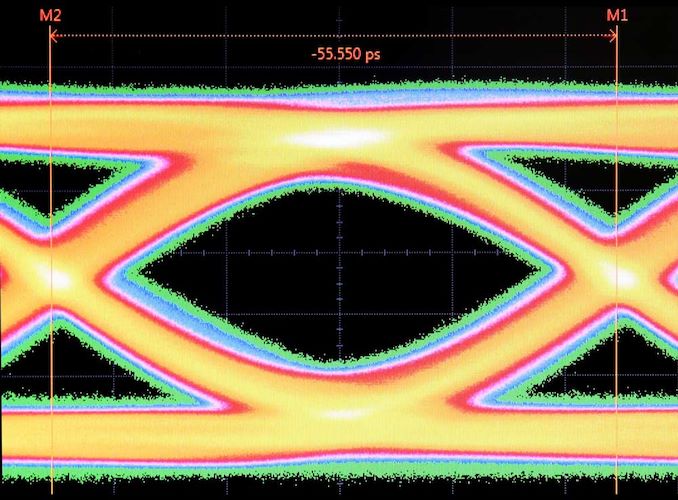Rambus Demonstrates GDDR6 Running At 18 Gbps
by Anton Shilov on November 1, 2019 1:00 PM EST
While GDDR6 is currently available at speeds up to 14Gbps, and 16Gbps speeds are right around the corner, if the standard is going to have as long a lifespan as GDDR5, then it can't stop there. To that end, Rambus this week demonstrated operation of its GDDR6 memory subsystem at a data transfer rate of 18 GigaTransfers/second, a new record for the company. Rambus’s controller and PHY can deliver a peak bandwidth of 72 GB/s from a single 32-bit GDDR6 DRAM chip, or a whopping 576 GB/s from a 256-bit memory subsystem, which is what we're commonly seeing on graphics cards today.
The Rambus demonstration involved the company’s silicon-proven GDDR6 PHY implemented using one of TSMC’s 7 nm process nodes, accompanied by Northwest Logic’s GDDR6 memory controller and GDDR6 chips from an unknown maker. According to a transmit eye screenshot published by Rambus, the subsystem worked fine and the signals were clean.
Both GDDR6 controller and PHY can be licensed from Rambus by developers of SoCs, so the demonstration is both a testament to how well the company’s highly-integrated 7 nm GDDR6 solution works, and a means to promote their IP offerings.
It is noteworthy that Rambus, along with Micron and a number of other companies, has been encouraging the use of GDDR6 memory in products besides GPUs for quite some time. Various accelerators for AI, ML, and HPC workloads as well as networking gear and autonomous driving systems greatly benefit from the technology's high memory bandwidth and are therefore a natural fit for GDDR6. The demonstration is meant to show companies developing SoCs that Rambus has a fine GDDR6 memory solution implemented using a leading-edge process technology that can be easily integrated (with the help of engineers from Rambus) into their designs.
For the graphics crowd, Rambus’ demonstration gives a hint of what to expect from upcoming implementations of GDDR6 memory subsystems and indicates that GDDR6 still has some additional room for growth in terms of data transfer rates.
Related Reading:
- Micron, Rambus, & Others Team Up To Spur GDDR6 Adoption in Non-GPU Products
- Cadence Tapes Out GDDR6 IP on Samsung 7LPP Using EUV
- Samsung Updates on GDDR6 Portfolio: 8 Gb and 16 Gb at Multiple Speeds
- Samsung Pre-Announces 16 Gbps GDDR6 Chips for Next-Gen Graphics Cards
Source: Rambus










24 Comments
View All Comments
Marlin1975 - Friday, November 1, 2019 - link
Let me guess, they have a patent that covers it?F__K rambus.
mikeztm - Friday, November 1, 2019 - link
Obviously they don't have a patent that covers it.They have a ton of patents that cover this thing and cross link to all other patents they own .
Once you licensed something from them you are totally screwed.
patssle - Friday, November 1, 2019 - link
Maybe they can create RD-GDDR6 ram....pair it with an Intel i9-XXX-EE (Emergency Edition) processor...price it 5x the fastest AMD processor...and be able to claim fastest processor on the market.And we can party like it's 2004!
Foeketijn - Friday, November 1, 2019 - link
And at the same time, we should have an upvote button.mrvco - Friday, November 1, 2019 - link
I'm glad that the douchery of Rambus has not been forgotten.close - Monday, November 4, 2019 - link
It can't be forgotten by anyone who 20 years ago knew what RAM is. Or someone who had to pay for a CRIMM (for anyone who doesn't know, it's a dummy DIMM, similar to a SCSI terminator, that was needed to complete the pairs in the empty slots).Yojimbo - Friday, November 1, 2019 - link
Of course they have a patent that covers it. Don't you expect to be paid for your work? If you don't want to use their patents then buy someone else's PHYs. When ARM comes out and says they've developed a new GPU do you say "let me guess, they have a patent that covers it? F___K ARM." ??IntelUser2000 - Friday, November 1, 2019 - link
Rambus. Aren't they known by most as holding patents just to sue others?Not even Intel could deal with them. They were making Timna, a value-oriented CPU that uses RDRAM. Obviously using the expensive Pentium 4 to spread RDRAM was going to take too long and they had to make it cheaper somehow.
Timna still got killed because they couldn't justify the cost of RDRAM no matter how low they priced the CPU. RDRAM limped along a little longer in the early Northwood generation until it got dumped completely in 2003.
Yojimbo - Friday, November 1, 2019 - link
They may be known for that but only among people who have no idea what they are talking about. The patents that Rambus tried to sue people with were patents that they had developed themselves. The issue was an impropriety with the way they got those patents introduced into the memory standards.Regarding Intel, again, that is a mischaracterization of the situation. Intel did deal with Rambus. The people Intel couldn't deal with were the memory manufacturers. The memory manufacturers didn't like being told what to produce and they didn't like the idea that a proprietary memory product could become mainstream. RDRAM remained very expensive because memory manufacturers resisted the production of the memory. Incidentally, the resistance quite possibly was some form of an agreed upon concerted act by the memory manufacturers, which I am guessing would be illegal.
You know, it doesn't really matter to Rambus what consumers think of them because they don't sell any products to consumers. They sell to manufacturers and those manufacturers obviously are in position to know better. But it's just annoying to have to read the same false stuff every time the name Rambus is written.
bigboxes - Saturday, November 2, 2019 - link
Eff Rambus.